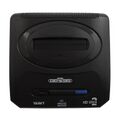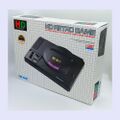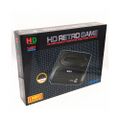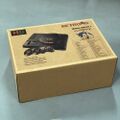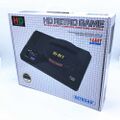Difference between revisions of "Fei Hao HD Retro Game"
From Sega Retro
| Line 62: | Line 62: | ||
<gallery> | <gallery> | ||
Feihao HD MD2 clone front.JPG|Revision 1 | Feihao HD MD2 clone front.JPG|Revision 1 | ||
| + | MD Clone Fei Hao MD2 Alt.jpg|Revision 1 | ||
</gallery> | </gallery> | ||
Revision as of 06:24, 29 November 2019

| |||||||||||||||
| Fei Hao HD Retro Game | |||||||||||||||
|---|---|---|---|---|---|---|---|---|---|---|---|---|---|---|---|
| Manufacturer: Fei Hao | |||||||||||||||
|
This short article is in need of work. You can help Sega Retro by adding to it.
The HD Retro Game is an unlicensed Sega Mega Drive clone console made by Fei Hao. It was first released in 2017 and is based around the TCT-6803 "console on a chip". It is also branded as Retroad.
The console is available in original Mega Drive and Mega Drive 2 form factors.
It has been sold under the Retro Genesis brand in Russia with 50, 150 or 225 built-in games (some translated into Russian) and stereo audio output.
The "Retro Genesis" variants have also been repackaged and sold in the "HD Retro Game" boxes.
Contents
- 1 Hardware
- 2 Revisions
- 3 Fei Hao HD Retro Game (model 1)
- 4 Fei Hao HD Retro Game (model 2)
- 5 Retroad Mega Drive Flashback (repackaged HD Retro Game)
- 6 Retroad Mega Drive Flashback (repackaged Retro Genesis HD Ultra with 50 built-in games)
- 7 Retroad HD Retro Game (repackaged Retro Genesis HD Ultra with 150 built-in games)
- 8 Retroad HD Retro Game (repackaged Retro Genesis HD Ultra 2 with 50 built-in games)
- 9 Retroad HD Retro Game (Retroad MD Genesis with 170 built-in games)
- 10 References
Hardware
The HD Retro Game was the first Mega Drive clone console to be spotted with HDMI support (alongside composite video) - while matched by the officially licensed Sega Mega Drive Flashback from AtGames later in the year, no official Mega Drive prior to this date could support HDMI without homebrew modifications, with the standard not even existing when the Mega Drive was in its prime. The HDMI output is 720p in widescreen only and is a conversion of the generated composite signal, as opposed to true RGB straight from the unit.
The HD Retro Game is infamous for being a more complete package than AtGames' attempts, despite lacking any official endorsement from Sega. While falling short of genuine Sega Mega Drive hardware, it is widely accepted to have superior audio to AtGames' machines, while offering similar 2.4GHz RF wireless control pads (in addition to accepting wired controllers). It is also compatible with Everdrive flash cartridges and high capacity multicarts, though Virtua Racing and the Sega 32X do not function at all.
On early models, despite having an HDMI output, dual audio jacks on the rear, and a headphone jack on the front (model 1 only), the console only outputs mono sound. The newer versions does have stereo audio output through the HDMI and the dual audio jacks on the rear, however the headphone jack is still dual mono. The new versions also have a more accurate color for the text and accents on the ring area on the console's shell.
It also only outputs an NTSC video signal, and while a region switch allows users to select NTSC-U and NTSC-J releases, PAL region-locked games are not compatible.
The system is largely compatible with the Power Base Converter, though often displays graphical artifacts and can struggle with specific titles (such as Chase H.Q.). The caveat, however, is that the "model 1" design of the console mounts its cartridge slot slightly lower, so the original Power Base Converter will not physically fit in the machine without removing the plastic casing.
Neither version of the HD Retro Game is compatible with the Sega Mega-CD. The model 1 design still has a detachable cover to access the expansion port, but removing it reveals no connectors. The model 2's expansion port cover is purely aesthetic, being molded as part of the bottom case.
The Mega Drive's shadow and highlight graphical modes are not correctly replicated on older versions of HD Retro Game, with some sprites subsequently appearing invisible. The new versions that started appearing in 2019 does have the shadow and highlight graphical modes but only through the composite av output port; the HDMI output port is still missing this mode. As a result of the revised circuitry to enable this graphical mode, the composite video quality is noticeably poorer than the previous versions.
Revisions
There have been a few revisions of the model 1 console.
The earliest models have the text "AV INTELLIGENT TERMINAL HIGH GRADE MULTIPURPOSE USE" printed in a pinkish color, as well as the area around the power LED. The power and volume switches do not have the engraved molding line painted. These units have dual mono sound only. It comes packaged in a box that has the same size as the original Japanese Mega Drive model 1 box. "FEI HAO" is printed on the front of the box.
The 2nd revision has the text "HD INTELLIGENT TERMINAL HIGH GRADE MULTIPURPOSE USE" printed in a pinkish color (although some still have the "AV..." text), as well as the area around the power LED. The power and volume switches have the engraved line painted in the same pinkish color. These units also have dual mono sound only. Some of these units were meant for export to the Russian market. Those have 50 built-in games added and have the "Retro Genesis" logo and the text "HD ULTRA WIRELESS GAMEPADS" printed on the console. From this point, the consoles are packaged in a smaller redesigned box and have stopped using the "FEI HAO" branding.
The 3rd revision has the text "HD INTELLIGENT TERMINAL HIGH GRADE MULTIPURPOSE USE" printed in a maroon color as well as the area around the power LED, which is more accurate to the real Mega Drive. The power and volume switches still have the pinkish color line engraved. These units are meant for export to the Russian market, have 150 or 225 built-in games added and have the "Retro Genesis" logo and the text "HD ULTRA WIRELESS GAMEPADS" printed on the console. These units are the first to have stereo audio output through HDMI and the stereo audio jacks, although the headphone jack is still in dual mono. However, the sound channels are reversed. This revision started to appear in 2018.
The 4th revision looks similar to the previous version, but lacks the "Retro Genesis" logo on the console while retaining the "HD ULTRA WIRELESS GAMEPADS" logo. The consoles are now branded as "RETROAD MD Genesis" and come in a redesigned box that opens from the front and has a carrying handle. These units have 170 built-in games. The audio circuitry is further revised, fixing the reversed sound channels, however the overall volume is slightly lower. The video circuitry is also revised to enable the shadow and highlight graphical modes that were absent in all previous versions. However these graphical modes are only present while using the composite av output port; the HDMI output port still lacks these graphical modes. As a result of the revised video circuitry, the composite video quality is noticeably poorer than all previous versions of the console. These units started to appear in 2019.
For the model 2 console, there are 2 versions.
The early models are completely black with "Mega Drive 2" and "16 Bit" logos printed on the console. These units have dual mono sound only.
The 2nd revision has a blue Reset button with "Retro Genesis HD Ultra 2" and "Wireless Gamepads" logos printed on the console. These units are meant for export to the Russian market and have 50 built-in games and stereo audio.
Fei Hao HD Retro Game (model 1)
Fei Hao HD Retro Game (model 2)
Retroad Mega Drive Flashback (repackaged HD Retro Game)
Retroad Mega Drive Flashback (repackaged Retro Genesis HD Ultra with 50 built-in games)
Retroad HD Retro Game (repackaged Retro Genesis HD Ultra with 150 built-in games)
Retroad HD Retro Game (repackaged Retro Genesis HD Ultra 2 with 50 built-in games)
Retroad HD Retro Game (Retroad MD Genesis with 170 built-in games)
References







